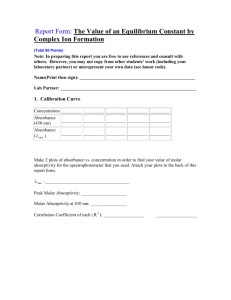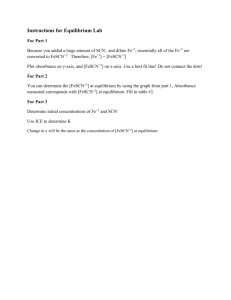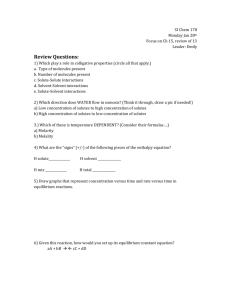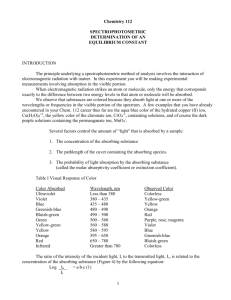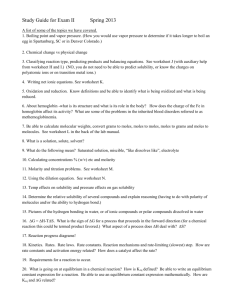A.P. CHEMISTRY Experiment 17 Determination of the Equilibrium
advertisement
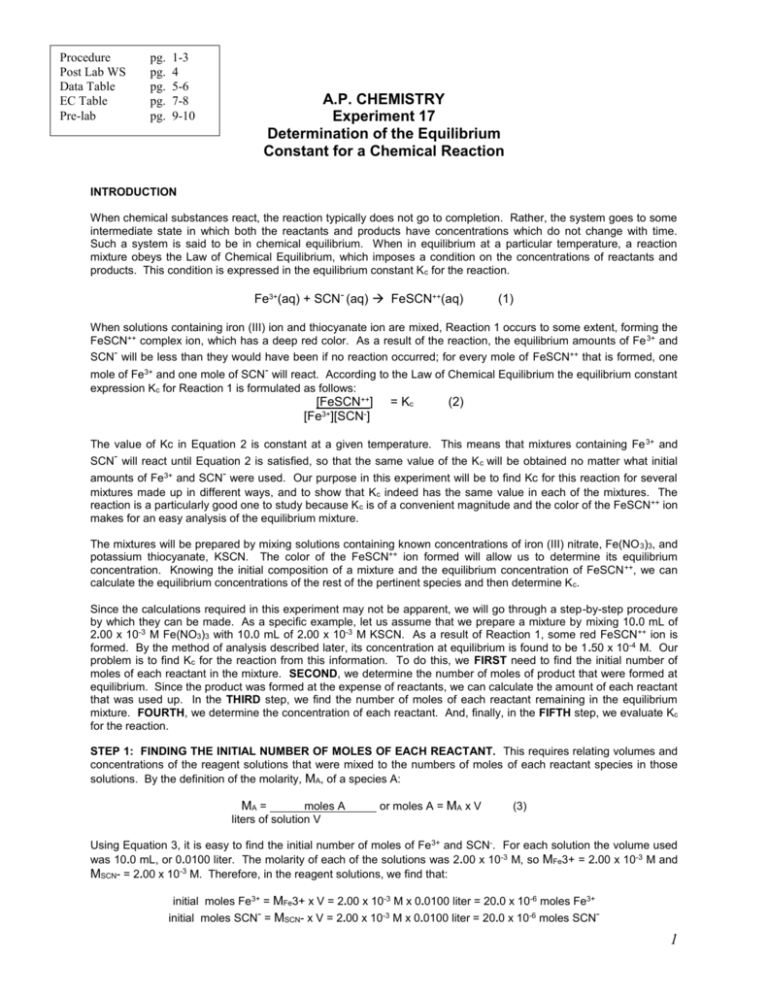
Procedure Post Lab WS Data Table EC Table Pre-lab pg. pg. pg. pg. pg. 1-3 4 5-6 7-8 9-10 A.P. CHEMISTRY Experiment 17 Determination of the Equilibrium Constant for a Chemical Reaction INTRODUCTION When chemical substances react, the reaction typically does not go to completion. Rather, the system goes to some intermediate state in which both the reactants and products have concentrations which do not change with time. Such a system is said to be in chemical equilibrium. When in equilibrium at a particular temperature, a reaction mixture obeys the Law of Chemical Equilibrium, which imposes a condition on the concentrations of reactants and products. This condition is expressed in the equilibrium constant K c for the reaction. Fe3+(aq) + SCN- (aq) FeSCN++(aq) (1) When solutions containing iron (III) ion and thiocyanate ion are mixed, Reaction 1 occurs to some extent, forming the FeSCN++ complex ion, which has a deep red color. As a result of the reaction, the equilibrium amounts of Fe 3+ and SCN- will be less than they would have been if no reaction occurred; for every mole of FeSCN++ that is formed, one mole of Fe3+ and one mole of SCN- will react. According to the Law of Chemical Equilibrium the equilibrium constant expression Kc for Reaction 1 is formulated as follows: [FeSCN++] [Fe3+][SCN-] = Kc (2) The value of Kc in Equation 2 is constant at a given temperature. This means that mixtures containing Fe 3+ and SCN- will react until Equation 2 is satisfied, so that the same value of the K c will be obtained no matter what initial amounts of Fe3+ and SCN- were used. Our purpose in this experiment will be to find Kc for this reaction for several mixtures made up in different ways, and to show that Kc indeed has the same value in each of the mixtures. The reaction is a particularly good one to study because K c is of a convenient magnitude and the color of the FeSCN ++ ion makes for an easy analysis of the equilibrium mixture. The mixtures will be prepared by mixing solutions containing known concentrations of iron (III) nitrate, Fe(NO 3)3, and potassium thiocyanate, KSCN. The color of the FeSCN++ ion formed will allow us to determine its equilibrium concentration. Knowing the initial composition of a mixture and the equilibrium concentration of FeSCN ++, we can calculate the equilibrium concentrations of the rest of the pertinent species and then determine Kc. Since the calculations required in this experiment may not be apparent, we will go through a step-by-step procedure by which they can be made. As a specific example, let us assume that we prepare a mixture by mixing 10.0 mL of 2.00 x 10-3 M Fe(NO3)3 with 10.0 mL of 2.00 x 10-3 M KSCN. As a result of Reaction 1, some red FeSCN ++ ion is formed. By the method of analysis described later, its concentration at equilibrium is found to be 1.50 x 10-4 M. Our problem is to find Kc for the reaction from this information. To do this, we FIRST need to find the initial number of moles of each reactant in the mixture. SECOND, we determine the number of moles of product that were formed at equilibrium. Since the product was formed at the expense of reactants, we can calculate the amount of each reactant that was used up. In the THIRD step, we find the number of moles of each reactant remaining in the equilibrium mixture. FOURTH, we determine the concentration of each reactant. And, finally, in the FIFTH step, we evaluate Kc for the reaction. STEP 1: FINDING THE INITIAL NUMBER OF MOLES OF EACH REACTANT. This requires relating volumes and concentrations of the reagent solutions that were mixed to the numbers of moles of each reactant species in those solutions. By the definition of the molarity, MA, of a species A: MA = moles A liters of solution V or moles A = MA x V (3) Using Equation 3, it is easy to find the initial number of moles of Fe 3+ and SCN-. For each solution the volume used was 10.0 mL, or 0.0100 liter. The molarity of each of the solutions was 2.00 x 10-3 M, so MFe3+ = 2.00 x 10-3 M and MSCN- = 2.00 x 10-3 M. Therefore, in the reagent solutions, we find that: initial moles Fe3+ = MFe3+ x V = 2.00 x 10-3 M x 0.0100 liter = 20.0 x 10-6 moles Fe3+ initial moles SCN- = MSCN- x V = 2.00 x 10-3 M x 0.0100 liter = 20.0 x 10-6 moles SCN- 1 STEP 2: FINDING THE NUMBER OF MOLES OF PRODUCT FORMED. Here again we can use Equation 3 to advantage. The concentration of FeSCN++ was found to be 1.50 x 10-4 M at equilibrium. The volume of the mixture at equilibrium is the sum of the two volumes that were mixed, which equals 20.0 mL, or 0.0200 liter. So: equil. moles FeSCN++ = MFeSCN++ x V = 1.50 x 10-4 M x 0.0200 liter = 3.00 x 10-6 moles FeSCN++ The number of moles of Fe3+ and SCN- that were used up in producing the FeSCN++ must also both be equal to 3.00 x 10-6 moles since, by Equation 1, it takes one mole Fe3+ and one mole SCN- to make each mole of FeSCN++. STEP 3: FINDING THE NUMBER OF MOLES OF EACH REACTANT PRESENT AT EQUILI- BRIUM. In Step 1 we determined that initially we had 20.0 x 10-6 moles Fe3+ and 20.0 x 10-6 moles SCN- present. In Step 2 we found that in the reaction 3.00 x 10-6 moles Fe3+ and 3.00 x 10-6 moles SCN- were used. The number of moles present at equilibrium must equal the number we started with minus the number that reacted. Therefore, at equilibrium: moles at equilibrium = initial moles - moles used equil. moles Fe3+ = 20.0 x 10-6 - 3.00 x 10-6 = 17.0 x 10-6 moles Fe3+ equil. moles SCN- = 20.0 x 10-6 - 3.00 x 10-6 = 17.0 x 10-6 moles SCNSTEP 4: FIND THE CONCENTRATION OF ALL SPECIES AT EQUILIBRIUM. Experimentally, we obtained the concentration of FeSCN++ directly. [FeSCN++] = 1.50 x 10-4 M. The concentrations of Fe3+ and SCN- follow from Equation 3. The number of moles of each of these species at equilibrium was obtained in Step 3. The volume of the mixture being studied was 20.0 mL, or 0.0200 liter. So, at equilibrium: [Fe3+] = MFe3+ = moles Fe3+ = 17.0 x 10-6 moles = 8.5 x 10-4 M volume of solution 0.0200 liter [SCN-] = MSCN- = moles SCN- = 17.0 x 10-6 moles = 8.5 x 10-4 M volume of solution 0.0200 liter STEP 5: FINDING THE VALUE OF Kc FOR THE REACTION. Once the equilibrium concentrations of all the reactants and products are known, one needs merely to substitute into Equation 2 to determine Kc: Kc = [FeSCN++] = 1.50 x 10-4 M 3+ [Fe ][SCN-] (8.5 x 10-4 M) x (8.5 x 10-4 M) = 208 M-1 In this experiment you will obtain data similar to that shown in this example. The calculations involved in processing that data are completely analogous to those we have made. (Actually, your results will differ from the ones we obtained, since the data in our example were obtained at a different temperature and so relate to a different value of Kc.) In carrying out this analysis, we made the assumption that the reaction which occurred was given by Equation 1. There is no inherent reason why the reaction might not have been: Fe3+(aq) + 2 SCN-(aq) Fe(SCN)2+ (5) If you are interested in matters of this sort, you might ask how we know whether we are actually observing Reaction 1 or Reaction 5. The line of reasoning is the following. If Reaction 1 is occurring, K c for that reaction as we calculate it should remain constant with different reagent mixtures. If, however, Reaction 5 is the one that is going on, K c as calculated for that reaction should remain constant. In the extra credit part of the Calculations section, we will assume that Reaction 5 occurs, and make the analysis of Kc on that basis. The results of the two sets of calculations should make it clear that Reaction 1 is the one that we are studying. Two analytical methods can be used to determine [FeSCN ++] in the equilibrium mixtures. The more precise method uses a spectrophotometer, which measure the amount of light absorbed by the red complex at 447 nm, the wavelength at which the complex most strongly absorbs. The absorbance, A, of the complex is proportional to its concentration, M, and can be measured directly on the spectro- photometer. A = kM (6) 2 Your instructor will show you how to operate the spectrophotometer, and will provide you with a calibration curve from which you can find [FeSCN++] once you have determined the absorbance of your solutions. In preparing the mixtures in this experiment, we will maintain the concentration of H + ion at 0.5 M. The hydrogen ion does not participate directly in the reaction, but its presence is necessary to avoid the formation of brown-colored species such as FeOH++, which would interfere with the analysis of [FeSCN++]. EXPERIMENTAL PROCEDURE: Label five cuvettes 1 to 5, with labels or by noting their positions on your test tube rack. Pour about 15 mL 2.00 x 10-3 M Fe(NO3)3 in 1 M HNO3 into a dry 100-mL. beaker. Pipet 2.50 mL of that solution into each cuvette. Then add about 15 mL 2.00 x 10-3 M KSCN to another dry 100-mL beaker. Pipet 0.50, 1.00, 1.50, 2.00, and 2.50 mL from the KSCN beaker into each of the corresponding cuvettes labeled 1 to 5 (with a clean, dry pipet). Then pipet the proper number of mL of water with a clean pipet into each cuvette to bring the total volume in each tube to 5.00 mL. The volumes of reagents to be added to each tube are summarized in Table 1: Vol. in mL. 2.00 x 10-3 M Fe(NO3)3 in 1 M HNO3 Vol. in mL. 2.00 x 10-3 M KSCN Vol. in mL. Water 2.50 0.50 2.00 2.50 1.00 1.50 2.50 1.50 1.00 2.50 2.00 0.50 2.50 2.50 0.00 Mix each solution thoroughly with a glass stirring rod. Be sure to dry the stirring rod after mixing each solution. Pipets can be cleaned by rinsing each twice with distilled water, and once with alcohol. Place back in appropriately labeled pipet rack to dry. ANALYSIS BY SPECTROPHOTOMETRIC MEASUREMENT: The spectrophotometer should be set to 447 nm. Set the spectrophotometer to read 0% Transmittance with the path blocked (no cuvette in the holder). Fill a cuvette with distilled water, clear the cuvette of air bubbles and finger prints, and place the cuvette in the cuvette holder as demonstrated by your instructor (white arrow/line lines up with the black line on the spectrophotometer). Adjust the spectrophotometer to read 100% transmittance. (Now go back and make sure the spectrophotometer still reads 0% with the path blocked and then that it reads 100% with the distilled water cuvette.) Next, insert the cuvette with solution 1 and measure the percent transmittance of the solution. Repeat the measurement using the solutions in each of the other cuvettes. After recording the percent transmittance for each solution, use a calculator to compute the absorbance for each solution. The equation for this conversion is: Absorbance = Log10 100 % Transmittance Determine the concentration of FeSCN++ from the calibration curve provided for each instrument (a copy is placed on the lab room wall). Be careful to use the calibration curve for the instrument you used as they are slightly different. Pour solutions out; clean your cuvettes by rinsing each twice with distilled water, and once with alcohol. Dry the outsides of the cuvettes. Return to instructor by placing them inverted in cuvette rack. Be sure to put your set in the cuvette rack in the appropriately labeled location. 3 AP CHEMISTRY Post Lab: Kc Experiment #17 1. Name: ________________ Take a look at your data table and the absorbance values in mixtures 1-5. Is there any general trend? Should there be? Explain. 2. The concentration of FeSCN2+ increases from mixture 1-5. Explain. 3. Look at your Kc values. Is there any general trend shown? Should their be? Explain. 4. How exactly could air bubbles affect your data? Your Kc values? 5. How exactly could fingerprints affect your data? Your Kc values? 6. Describe completely (in as few words as possible) how we were able to calculate Kc using this experimental procedure. (In other words, I'm looking for you to show me that you understood why you did what you did. This explanation should have very little to do with the steps themselves, but more with the big picture.) 4 Data: Determination of Equilibrium Constant, Kc, for a Chemical Reaction Mixture Vol. in ml. 2.00 x 10-3 M Fe(NO3)3 Vol. in ml. 2.00 x 10-3 M KSCN Vol. in ml. of Water 1 2.50 0.50 2.00 2 2.50 3 2.50 4 2.50 5 2.50 1.00 1.50 2.00 2.50 Percent Transmittance Absorbance Equilibrium [FeSCN2+] _______ _______ _____ x 10-4 M _______ _______ _____ x 10-4 M _______ _______ _____ x 10-4 M _______ _______ _____ x 10-4 M _______ _______ _____ x 10-4 M 1.50 1.00 0.50 0.00 Calculations: Mix. Initial No. Moles Equilibrium No. Moles Equilibrium Concentrations Kc Fe3+ (x 10-6) SCN(x 10-6) Fe3+ (x 10-6) SCN(x 10-6) FeSCN2+ (x 10-6) [Fe3+] (x 10-4) [SCN-] (x 10-4) [FeSCN2+] (x 10-4) (Label) 1 _______ _______ _______ _______ _______ _______ _______ _______ _______ 2 _______ _______ _______ _______ _______ _______ _______ _______ _______ 3 _______ _______ _______ _______ _______ _______ _______ _______ _______ 4 _______ _______ _______ _______ _______ _______ _______ _______ _______ 5 _______ _______ _______ _______ _______ _______ _______ _______ _______ 5 PART A: Calculation of Kc Assuming the Reaction Fe3+(aq) + SCN-(aq) FeSCN++(aq). (1) This calculation is most easily done by Steps 1 through 5 in the discussion. Results are to be entered in the table on the following page. STEP 1. Find the initial number of moles of Fe 3+ and SCN- in the mixtures in test tubes 1 through 5. Use Equation 3 and enter the values in the first two columns in the table. STEP 2. Enter the experimentally determined value of [FeSCN++] at equilibrium for each of the mixtures in the next to last column in the table. Use Equation 3 to find the number of moles of FeSCN++ in each of the mixtures, and enter the values in the fifth column in the table. Note that this is also the number of moles of Fe3+ and SCN- that were used up in the reaction. STEP 3. From the number of moles of Fe3+ and SCN- initially present in each mixture, and the number of moles of Fe3+ and SCN- used up in forming FeSCN++, calculate the number of moles of Fe 3+ and SCN- that remain in each mixture at equilibrium. Use Equation 4. Enter the results in Columns 3 and 4 in the table. STEP 4. Use Equation 3 and the results of Step 3 to find the concentrations of all of the species at equilibrium. The volume of the mixture is 5.00 mL, or 0.00500 liter in all cases. Enter the values in Columns 6 and 7 in the table. STEP 5. Calculate Kc for the reaction for each of the mixtures by substituting values for the equilibrium concentrations of Fe3+, SCN-, and FeSCN++ in Equation 2. 6 A.P. CHEMISTRY Name: _________________________ PART B: (Extra Credit) In calculating Kc in Part A, we assume, correctly, that the formula of the complex ion is FeSCN++. It is by no means obvious that this is the case and one might have assumed, for instance, that Fe(SCN)2+ was the species formed. The reaction would then be: Fe3+(aq) + 2 SCN-(aq) Fe(SCN)2+(aq) (5) If we analyze the equilibrium system we have studied, assuming that Reaction 5 occurs rather than Reaction 1, we would presumably obtain nonconstant values of Kc. using the same kind of procedure as in Part A (but using this new equation), calculate Kc for Mixtures 1, 3, and 5 on the basis that Fe(SCN) 2+ is the formula of the complex ion formed by the reaction between Fe3+ and SCN-. Because of the procedure used for calibrating the system, [Fe(SCN)2+] will equal one-half the [FeSCN++] obtained for each solution in Part A. Mix. 1 3 5 Initial No. Moles Equilibrium No. Moles Equilibrium Concentrations Kc Fe3+ (x 10-6) SCN(x 10-6) Fe3+ (x 10-6) SCN(x 10-6) Fe(SCN)2+ (x 10-6) [Fe3+] (x 10-4) [SCN-] (x 10-4) [Fe(SCN)2+] (x 10-4) (Label) _______ _______ _______ _______ _______ _______ _______ _______ _______ _______ _______ _______ _______ _______ _______ _______ _______ _______ _______ _______ _______ _______ _______ _______ _______ _______ _______ On the basis of the results of Part A compared to the results from Part B, what can you conclude about the validity of the equilibrium reactions, as exemplified by Reaction (1) versus Reaction (5)? _____________________________________________________________________________________________ _____________________________________________________________________________________________ What is the correct formula of the iron (III) thiocyanate complex ion? ______________________________ 7 8 A.P. CHEMISTRY Experiment 17 Name: ___________________________ Block: _________ PRELAB ASSIGNMENT: Determination of the Equilibrium Constant for a Reaction. 1. A student mixes 5.00 mL 2.00 x 10-3 M Fe(NO3)3 with 5.00 mL 2.00 x 10-3 M KSCN. She finds that in the equilibrium mixture, the concentration of FeSCN++ is 1.40 x 10-4 M. Find Kc for the reaction Fe3+(aq) + SCN-(aq) FeSCN++(aq). STEP 1. Find the number of moles Fe3+ and SCN- initially present. (Use Eq. 3.) moles SCN- moles Fe3+: STEP 2. How many moles FeSCN++ are in the mixture at equilibrium? What is the volume of the equilibrium mixture? (Use Eq. 3.) mL: moles FeSCN++ How many moles of Fe3+ and SCN- are used in making the FeSCN++? moles SCN- moles Fe3+: STEP 3. How many moles of Fe3+ and SCN- remain in the solution at equilibrium? (Use. Eq. 4 and the results of Steps 1 and 2.) moles SCN- moles Fe3+: STEP 4. What is the volume of the equilibrium mixture? (Use Eq. 3 and the results of Step 3.) mL. What are the concentrations of Fe3+, SCN-, and FeSCN++ at equilibrium? [Fe3+] = STEP 5. M; [SCN-] = M; [FeSCN++] = M What is the value of Kc for the reaction? Be sure to include the unit. (Use Eq. 2 and the results of Step 4.) Kc = 9 2. Assume that the reaction studied in Problem 1 is Fe 3+(aq) + 2 SCN-(aq) Fe(SCN)2+(aq). Find Kc for this reaction, given the data in Problem 1, except that the equilibrium concentration of Fe(SCN) 2+ is equal to 7.10 x 10-5 M. A. Formulate the expression for Kc for the alternate reaction just cited. B. Find Kc as you did in Problem 1; take due account of the fact that two moles SCN - are used up per mole Fe(SCN)2+ formed. STEP 1. Results are as in Problem 1. STEP 2. How many moles of Fe(SCN)2+ are in the mixture at equilibrium? (Use Eq. 3.) moles Fe(SCN)2+ How many moles of Fe3+ and SCN- are used up in making the Fe(SCN)2+? moles Fe3+; STEP 3. moles SCN- How many moles of Fe3+ and SCN- remain in solution at equilibrium? Use the results of Steps 1 and 2, noting that moles SCN- at equilibrium = original moles SCN- - (2 x moles Fe(SCN)2+). moles Fe3+; STEP 4. What are the concentrations of Fe3+, SCN-, and Fe(SCN)2+ at equilibrium? (Use Eq. 3 and the results of Step 3.) [Fe3+] = STEP 5. moles SCN- M; [SCN-] = M; [Fe(SCN)2+] = M Calculate Kc on the basis that the alternate reaction occurs. Be sure to include the unit. (Use the answer to Part A and show set-up.) Kc = _____________________ 10
